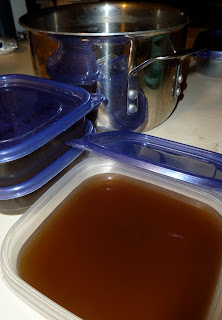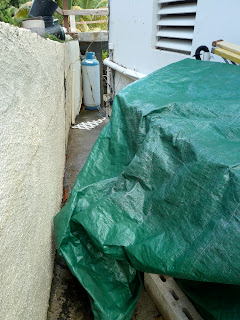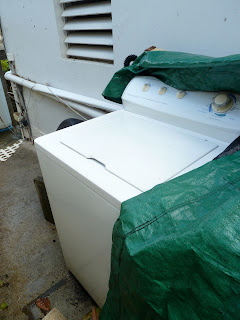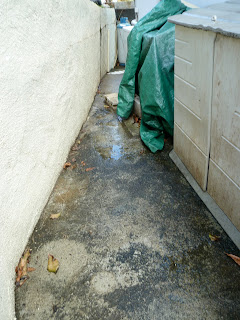So once upon a time (maybe like two years ago?) I went over to friends house and watched her throw some almonds into her food processor. I asked her what she was making and she said almond butter. Who the? What the? You can MAKE almond butter? Oh yes, she says, and peanut butter. Not only that, she started it up and then left to take a shower. Setting aside for the moment that for some reason I was hanging out in a friend's kitchen while she had better things to do, like go and take a shower, this almond butter needed virtually no work. So after I got the hint that she had places to be which did not involve me loitering at her kitchen table, I zipped home up the mountain to make my own delicious jar of almond butter. I threw the almonds in my food processor, hit the button, and stood back proudly watching while my almonds miraculously morphed into butter my food processor started making terrible noises. Like a combo of nails on a chalkboard and dying puppies. Then there was smoke. And then there was silence. Terrible silence.
Soooo, apparently using a not so great food processor doesn't work for almond butter. I had one of those convenient looking blender/food processor combos. Yes. Had. The almonds killed it. But never fear. A mere 250 Discover points later and another big new fancy-schmancy 12 cup food processor was on its way. (I buy groceries with my card and they give me points for food processors and Gap gift cards. Me and Discover, we've got a good thing going.) Of course, it wasn't on its way to St. Thomas. Because 90% of the universe doesn't ship to St. Thomas. (Because they're jealous.) It was on its way to friend's dad's house in south Florida. When she went up to see her family the next month, it was there. Actually there were two of them there. Silly Amazon. But we didn't realize this. We all thought one of them was the processor and one was accessories. For 250 Discover points you should get two boxes, right? So imagine our surprise when we picked up two very large boxes from the post office, each containing a new food processor and accessories. Seth spent the next four (FOUR!) months trying to explain to the nice not-very-good-at-English call center guys why we needed a free label to mail them back a rather heavy food processor from an island they don't even ship to, and no we don't need a refund thankyouverymuch. (Four months!) At one point we were in possession of two $300 food processors and a full refund onto our credit card for another. Good thing we're honest, Amazon. Good thing.
And so, with my one new food processor, I got to try my hand at almond butter again. It was just as easy as I remembered. Want to give it a whirl? Have a heavy duty food processor up to the challenge? Start out by toasting up about four cups of almonds. Or buy them pre-toasted if you're fancy like that. My kitchen isn't very scientific. I put them in a 350ish degree oven for ten minutes or so, tasting them occasionally. Usually burning my fingertips and tongue in the process because I'm one of the world's most impatient people. The more you toast them, the toastier your almond butter will taste. I suppose you could also make almond butter with raw almonds if you prefer.
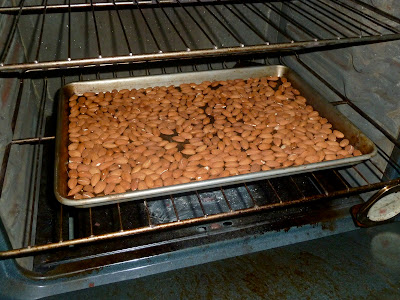
Now toss your toasted almonds into your food processor. It's okay if they're still hot. Fasten the lid and turn it on. And that's it. You don't even have to scrape down the sides with a spatula during the process. Just walk away. But for you guys I didn't just walk away. I took pictures at one minute intervals to give an idea of what you should be looking at.
See, here after one minute it gets kind of crumbly. It's more of an almond meal.
Kind of the same after two minutes.
It starts trying to form into a cohesive almond meal ball after three minutes.
After four minutes a mutant almond swamp monster emerges. Whatever you do, do not open the lid at minute four. You do not want to release that swamp monster into your home. He's kind of like Chucky with the aroma of toasted almonds.
After five minutes you have vanquished the almond swamp monster. Good job. You can put down the baseball bat and let your kids safely out of their bedroom closets.
You're going to start thinking you're done after six minutes. And maybe you are. But you're probably not. Taste it and see. Your processor might be different from mine. You'll also want to add a bit of salt and bit of sugar or honey at this point.
My almond butter is traditionally done after seven minutes. It's smooth and creamy. The longer you process it the more liquid-y it will get. Add a little more salt or sugar if you need to. Just give it a few little zzt-zzts with the pulse button to mix it in.
And that's that. Fresh almond butter minus any preservatives. I keep mine in a cabinet at room temperature, like peanut butter. And speaking of peanut butter, make it the exact same way. My peanut butter usually takes a minute or two less than my almond butter.
Homemade Almond Butter
- This makes about 2 cups of almond butter.
- Important: I have a 12 cup Kitchenaid and my friend uses a 10 cup Cuisinart. Don't use your little 4 cup anything. I'm pretty sure it won't be up to the challenge (meaning: the almonds will kill it). This is better suited for the motor in heavy duty food processors.
4 c. almonds
salt
sugar or honey (or sweetener of your choice)
Heat your oven to 350F. Spread out the almonds on a sheet pan and toast them in the oven for about 10 minutes. Keep checking to make sure you don't burn them. The toastier your almonds, the toastier your almond butter will be. Once the almonds are toasted, transfer them to your food processor and process them for about 7 minutes. After about 6 minutes, add the salt and sugar. I usually start with about a 1/2 tsp of each and work up from there. It's really subjective and up to your taste. Process until it's smooth and creamy, the consistency of peanut butter!





